Pallet Survey: The pulse on pallets
From wood to plastic to pallet pools, our readers tell us what’s important in pallets.
Latest Logistics News
FTR Shippers Conditions Index enters negative territory DAT March Truckload Volume Index sees modest March gains National diesel average, for week of April 22, is down for the second straight week UPS reports first quarter earnings declines LM Podcast Series: Assessing the freight transportation and logistics markets with Tom Nightingale, AFS Logistics More NewsAt first glance, the pallet market may appear to evolve at the same pace as those pre-historic looking reptiles found on small, forgotten islands. However, between a shortage of quality used pallets, new requirements from Costco and the introduction of a new pallet pool from a consortium of manufacturers, the past year has seen a number of new developments in the pallet market.
Have those developments filtered down to the manufacturers, wholesalers and retailers among Modern’s pallet-using readers? And, what moves our readers when it comes to pallets? Those are among the questions we explored in this year’s annual pallet survey.
Read last year’s Pallet Survey.
Check out the State of the Pallet Market Webcast from last month.
To answer them, we surveyed e-mail subscribers of Modern as well as a sample of recipients of our e-newsletters. We received 672 qualified responses, defined as a reader who is employed at a location that uses pallets. Here’s what we learned.
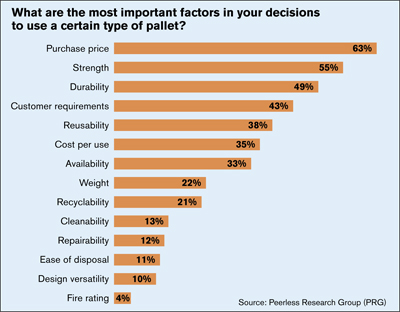
The who, what and how of pallets
Who is using pallets, what are they using, and how are they using them?
For starters, most respondents (58%) are involved in manufacturing, with a variety of industries represented. Wholesale distributors (17%) and retailers (6%) are also represented.
The respondents represent a solid mix of large companies with revenues exceeding $1 billion (17.5%), mid-size companies with revenue of between $250 million and $999 million (12.2%) and small companies with revenue below $250 million (70.3%).
For these users, a number of factors go into the decision to buy a certain type of pallet, but the purchase price is still the most important factor, cited by 63% of readers. The cost per use is cited by 35% of readers, suggesting that readers are getting more than one trip out of their pallets.
Other factors include:
- 55% strength
- 49% durability
- 43% customer requirements
- 38% reusability
- 33% availability
Wood pallets are still predominate. They are used by 94% of readers—no surprise there. However, pallets manufactured from alternative materials are in the mix, with some readers also using:
- 40% plastic pallets
- 17% wood composite
- 8% cardboard/corrugated
- 7% metal
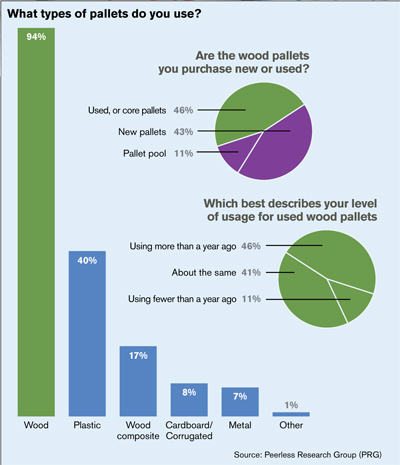
While there was a large demand for plastic pallets a few years ago following the introduction of a pool of plastic pallets by iGPS, demand for plastic pallets among Modern’s readers is largely unchanged in the last year. While 27% report they are using more plastic pallets, 13% are using fewer and 60% say there has been no change in their use of plastic.
We suspect that non-wooden pallets are being used in niche applications, such as captive pallets in a manufacturing operation, to ship back and forth to regular suppliers or customers or as a result of a customer requirement.
The 48 x 40-inch pallet is the most commonly used size, cited by 81% of readers. No surprise there either. What did catch our attention was that nearly 10% of respondents say they are shipping on a 24 x 20-inch half pallet. That is a relatively new size developed for the beverage industry, but it may also have applications for end-of-aisle displays.
Our readers’ pallets are circling the globe: nearly 57% of readers say they are shipping to both domestic and international customers; 39% of readers are only shipping domestically; and 4% are only shipping internationally.
The leading recipient is Canada (74%), followed by Mexico/South America/Caribbean (66%), China/Asia (57%), Western Europe (48%) and Eastern Europe (36%).
International business does require a different pallet strategy for most shippers, with only 21% reporting that they don’t do anything differently for international and domestic deliveries. Readers reported that 48% treat their pallets; 20% use alternative materials other than wood that don’t require treatment; 16% use wood pallets from their own pool; and 3% use a pallet pool for international shipments.
Watch the number of treated pallets in the future, especially if Canada and the United States finally agree on a proposal to treat pallets traveling between the countries in the future. That will lead to more readers treating their pallets or shipping on alternative materials.
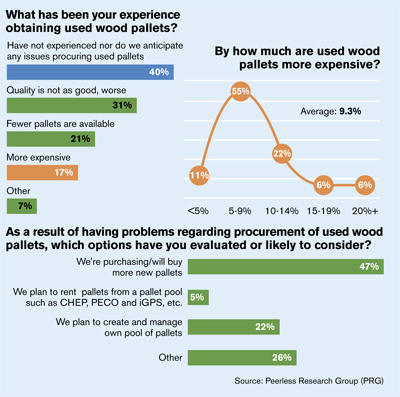
New or used
One of the most significant changes in the pallet industry over the last two decades has been the domination of used wooden pallets in the 48 x 40-inch pallet market. Although precise records aren’t kept, some have estimated that used pallets account for 60% or more of that market. Modern’s readers are no different, although their responses give a more nuanced view.
Nearly 63% report that they rely on used pallets, also known as cores. Of those, 46% say they are purchasing more used pallets than they did a year before.
At the same time, 59% of readers are also using new pallets and nearly 47% expect to purchase more new pallets next year. In other words, it’s not an either/or world when it comes to new versus used.
The demand for new pallets is, at least in part, a response to the shortage of cores that has plagued the market in 2011.
Although 40% say they have not experienced any issues in procuring used pallets, a majority has been impacted. Readers report that the quality of used pallets has deteriorated (31%), that fewer pallets are available (21%) and that they have become more expensive (17%). Of those readers who have experienced price increases, 55% have seen a spike of 5% to 9%, and 22% have seen a spike of from 10% to 14%.
In addition to purchasing more new pallets, 22% of readers plan to create and manage their own pool of pallets or rent from a pallet pool (5%) such as those from CHEP, PECO and iGPS to cope with the shortage of cores.
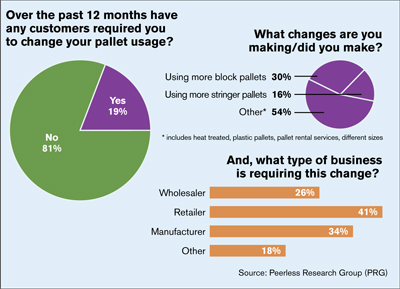
Block or stringer
In January 2011, Costco became the first retailer to require its suppliers to ship product on block pallets, which are similar in design, construction and quality to the pallets available from CHEP, PECO and iGPS. In this survey, we wanted to see if the Costco requirement is having an impact on the pallet market.
We discovered a couple of facts. As with the new versus used question, block or stringer isn’t an either/or question. Yes, more than half (53%) of readers are shipping solely on stringer pallets and 24% are shipping solely on block pallets. However, another 23% are shipping on block and stringer pallets in equal measure. In other words, a significant percentage (47%) is shipping some loads on block pallets.
Second, among the respondents, more than half are shipping to major retailers, big box store operators and grocery store chains. Of those, 33% ship to Walmart, 26% ship to Costco, 24% ship to a major grocery chain, and 21% ship to Sam’s Club. Readers are also shipping to other major retailers such as Target, Home Depot, Lowe’s, Walgreens, JCPenney and Macy’s.
A significant percentage of all readers (82%) report that no customer required them to change the type of pallet they were using for shipments in the past year. However, nearly 19% reported that they had changed their pallet usage in response to a customer requirement.
Of those, 31% say that they are using more block pallets and 54% say they are using alternatives to wooden pallets. Only 15% are using more stringer pallets in response to a customer requirement. In other words, while a relatively small number of respondents have been asked to change the type of pallet they are using, most have switched away from stringer pallets.
Asked what type of business is requiring them to change the type of pallet they are using, 41% responded that it was a retail customer, 34% a manufacturing customer and 26% a wholesale customer.
For now, Costco appears to be one of the few companies planning to require its suppliers to ship on block pallets. Only three readers from our survey indicated their company was considering a similar strategy.
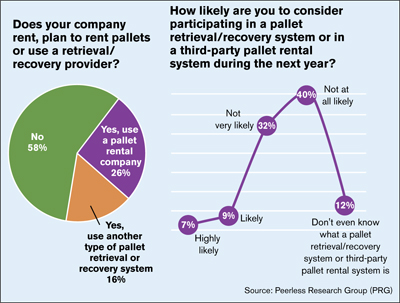
Get into the pool
Pallet pools have long been an alternative to purchasing new or used pallets. That has been true whether participation in a pool involved renting a pallet from CHEP, PECO or iGPS or a company managing its own assets. The latter is common among auto suppliers, food and beverage manufacturers, and the pharmaceutical industry that reuses plastic pallets.
Looking forward, it appears as if most companies plan to continue whatever strategy they are currently pursuing. Only 17% of readers said they are likely or highly likely to participate in a pallet pool in the coming year.
Of readers who would consider participating in a pallet pool, 41% reported that they would explore creating or managing their own pool; 28% said they have already evaluated or considered creating or managing their own pool.
Finally, we asked how interested are readers in using a pallet pooling service managed by the pallet industry as an alternative to established pools managed by CHEP, PECO and iGPS.
Roughly 14% indicated they are interested or highly interested. And, 66% indicated that they are not very or not at all interested.
That could indicate that the pallet industry needs to do more work to educate readers on what it may offer and how they may benefit from a new pool.

Article Topics
Latest in Logistics
FTR Shippers Conditions Index enters negative territory DAT March Truckload Volume Index sees modest March gains National diesel average, for week of April 22, is down for the second straight week UPS reports first quarter earnings declines LM Podcast Series: Assessing the freight transportation and logistics markets with Tom Nightingale, AFS Logistics Investor expectations continue to influence supply chain decision-making The Next Big Steps in Supply Chain Digitalization More LogisticsAbout the Author
Subscribe to Logistics Management Magazine

Find out what the world's most innovative companies are doing to improve productivity in their plants and distribution centers.
Start your FREE subscription today.
April 2023 Logistics Management

Latest Resources














